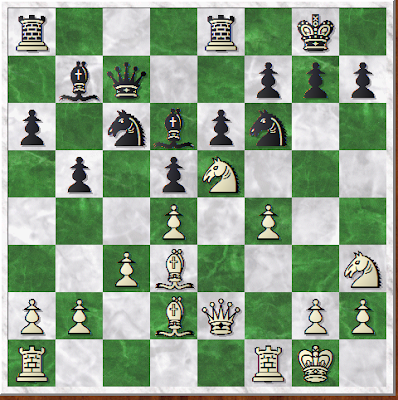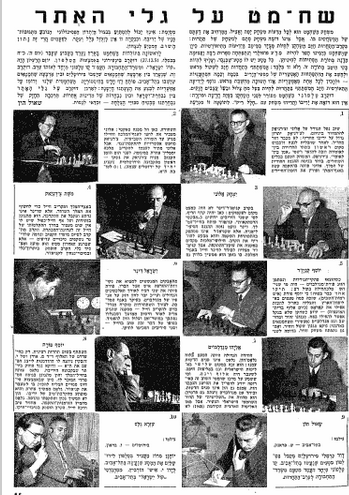Barav was called by Shaul Hon (in Taharum Amanim Be'Sachmat [Master Chess Tournament], Tel Aviv: "Tel Aviv: "Omanuth", 1952, pp. 92-93) 'one of the greatest tacticians in our country' and a 'exemplary blitz player'.
He was also an organizer: he was one of those who established the Palestine Chess Federation, organized the sending of the Israeli teams to the Olympiads in the 1950s, headed the Israel Chess Federation for a while in the 50s, and so on.
His son, Ami Barav, apart from supplying me with the above information, also kindly gave me press clippings and score sheets of such games. One of them is between Barav and Vidor, the scoresheet given to me by his son:
 |
| Source: Ami Barav's collection. |
The game was published, not only in Mendelbaum's and Persitz's ook (pp. 92-93), but, as part of Barav's obituary, in Shachmat vol. 11 no. 8 (Aug. 1979), p. 176. The obituary was written, and the game analyzed, by Avshalom Yosha. His is the analysis below, unless otherwise indicated.
Dutch Defense, Staunton Gambit (A82)
Lakser
Club "Yovel" championship, 05.02.1944
1.d4 f5 2.e4 fxe4 3.Nc3 Nf6 4.Bg5 e6 5.Bxf6 Qxf6 6.Nxe4 Qg6 (Better is 6...Qh6) 7.Ng3 Be7 8.Bd3 Qf7 9.Nf3 Nc6 10.c3 b6 11.Qe2 Bb7 12.0–0
0–0–0 13.a4! Bf6? (13...g5 required) 14.b4 h5 15.a5 h4? (better is 15...g5) 16.Ne4 h3 17.g3 Qh5 18.axb6 axb6? (The
file should not have been opened, but even after 18...cxb6 19.Ba6 white is Much better.) 19.Ba6 Nb8 20.Bxb7+
Kxb7 21.Qc4!
'The beginning of a majestic combination' (Yosha). 'It too me 45 minutes, then I calculated a 12-move combination. Persitz
would come to me to show me another variation every time, but I showed him I
calculated it all.' (Israel Barav, from his son's recollection).
21...Qd5 (21...Qxf3 22.Ra7+! Kxa7 23.Qxc7+ Ka6
24.Ra1+ Kb5 25.Nd6#) 22.Ra7+ Kxa7 23.Qxc7+ Qb7 (23...Ka6 24.Ra1+ Kb5
25.c4+ etc.) 24.Ra1+ Na6 25.Rxa6+
Kxa6 26.Nc5+ Kb5 (26...bxc5 27.Qa5#) 27.Nxb7 Ra8 28.Nd6+ Ka4 29.Qc4 Ka3
30.Nd2 Kb2 31.Qb3+ and Black resigned (1-0), due to 31...Kc1 32.N2c4 Bg5 33.Kf1 with unavoidable mate:

'One of the most brilliant
combinations even made in the country' -- Mohilever (quoted in Yosha's article). Mohilever also remind the reader in Yosha's piece that that Barav
was one of the founders of the Palestine Chess Association, with Mohilever himself,
Nachum Lebounsky, Haim Reid, and others.
A search of secondary sources (books in Hebrew from the 1950s, chessbase's database, chessgames.com , etc.) find no games by Barav online, and only this specific game appeared once or twice in Hebrew-language sources. Ami Barav had done a significant service in saving some of his fathers games, which I plan to publish here periodically. Let us say now only that they justify Hon's statement about Barav's talent.
Edited to add: Barav notes that the correct spelling is 'Labounsky', not 'Levonsky'.














































